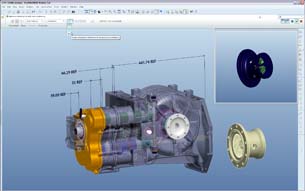Latest News
May 21, 2010
By Anthony J. Lockwood
Dear Desktop Engineering Reader:
 |
MCAD software is the heart of it all. Parts, machines, widgets, whatever you make depends on the quality of your designs and how well your design plays with other applications. Your entire engineering and manufacturing productivity and cost-effectiveness depends on your MCAD solution. And in the life of all small - and mid-size engineering and manufacturing organizations, the moment arrives when it is time to consider replacing your MCAD system because the old one is no longer up to the job. It’s slowing your design to manufacture process down, costing you money rather than enabling you to fully optimize your workflows.
Unnerving questions confront you: What do we need to succeed now and in the future? How do we define our requirements? How do we vet alternatives? Can we ensure that the MCAD environment we pick is the solution that meets our needs now and grows with us in the future? Can we avoid staking our business on a solution that is too light or more complex than we really need? What about intertwined concerns such as PDM, PLM, collaboration, interoperability, and integration with other vital in-house tools like CAE, CAM, and ERP? Where do we begin this process of re-engineering our design engineering environment? What can we do so that we know we answered the questions correctly and picked the right MCAD system for us?
Today’s Check It Out read doesn’t have all the answers to your unique circumstances. Only you have them. But it has 22 pages of sound advice, wisdom, helpful reminders, and straight talk to help you develop your plan for choosing a new MCAD system. Entitled “A Guide to Selecting a Mechanical CAD System for Small and Medium Businesses” and written by Ray Kurland – one of the best—this is a must read.
Kurland sets out in this paper to provide you what he calls “a logical and orderly approach, which, if followed, will allow you to select the proper” 3D MCAD system for your company. Note the word “proper.” He’s not talking about getting the most expensive, the most complex, the most bells and whistles. Kurland’s talking about fitting a new MCAD system to your company’s strategic imperatives like a tailor hand-making a suit for you.
Kurland starts at zero by defining MCAD and then progresses through all the questions you need to consider from whether or not you need a new MCAD system to functional requirements, technical requirements, selecting evaluation team members, sniffing out vendors, implementing your choice so that it succeeds, and so on. He even utters the unthinkable: “Remember this during the entire project: It’s a business decision, not a technical decision!”
That last one might be a tough one to swallow for some of you. But that’s the kind of straight talk you’re going to find everywhere in this paper. This is a thorough, no-nonsense guide for selecting a new MCAD system. My guess is that you’ll even find it a helpful reference for eyeballing other engineering systems. Kurland has not only written a must read as I said earlier. He’s written a keeper. Hit the link and check it out for yourself.
Thanks, Pal.—Lockwood
Anthony J. Lockwood
Editor at Large, Desktop Engineering
Subscribe to our FREE magazine, FREE email newsletters or both!
Latest News
About the Author
Anthony J. Lockwood is Digital Engineering’s founding editor. He is now retired. Contact him via [email protected].
Follow DE





